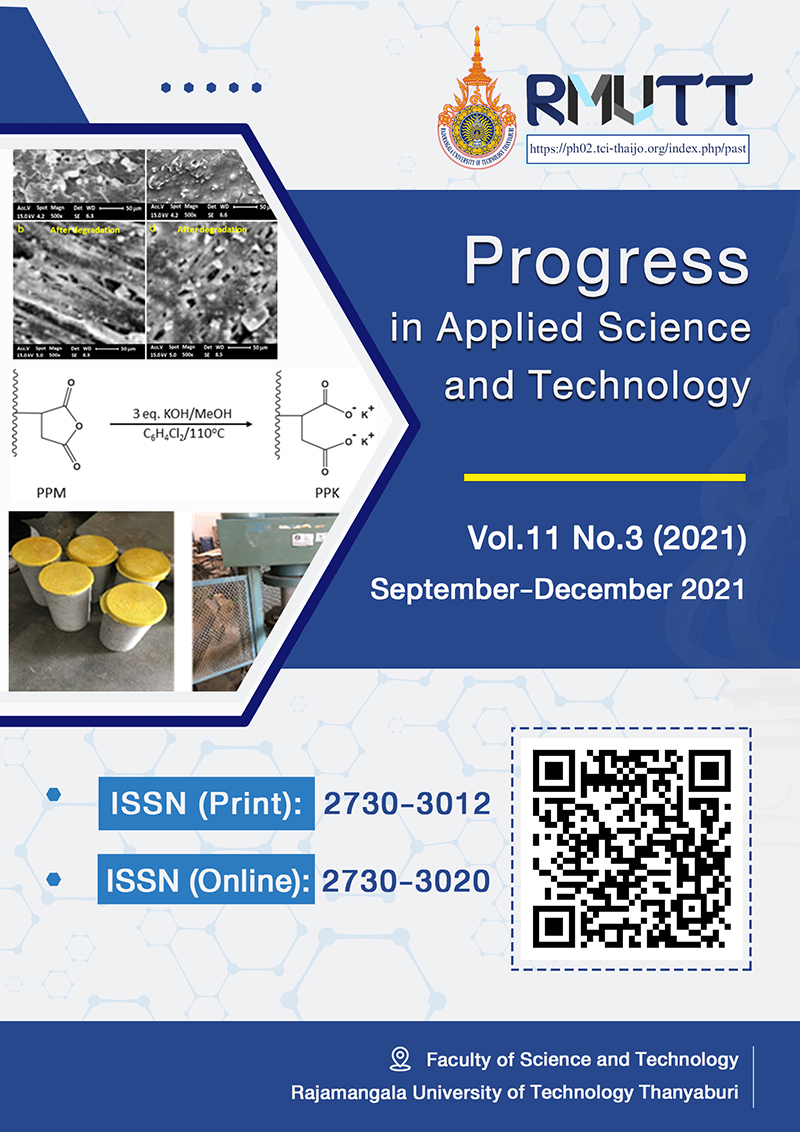Effect of Compatibilizing Agents on Organoclay Dispersion of Polypropylene/Organoclay Nanocomposites
Main Article Content
Abstract
The purpose of this research was to observe the effect of two compatibilizers, namely, maleated polypropylene (denoted as PPM) and potassium succinate-g-polypropylene (denoted as PPK), on the properties of polypropylene (PP)/PPM/organoclay (OC) or PP/PPK/OC ternary nanocomposite. Nanocomposites were made by melt blending PP directly with 5 wt% organoclay (Cloisite 15A, OC) using two separate compatibilizers with a fixed amount of 10 wt%. Transmission electron microscopy (TEM) photographs confirmed that the OC was intercalated and exfoliated within the presence of PP/PPM or PP/PPK during melt mixing. PPK compatibilized systems had better exfoliation of PP/OC nanocomposites than PPM compatibilized systems. Better dispersion and exfoliation state of OC was performed by adding PPK rather than PPM. PP/PPK/OC nanocomposites were found to have the most continuous and uniform size. The PPK compatibilized system has given higher tensile strength and tensile modulus but with less elongation at break (%) than in PPM compatibilized cases. Differential scanning calorimetry (DSC) assessment indicates an increase in melting temperature, crystallization temperature, and crystallinity. Moreover, the addition of PPK or PPM with OC enhances the rheological behaviors of nanocomposites.
Article Details

This work is licensed under a Creative Commons Attribution-NonCommercial-NoDerivatives 4.0 International License.
References
Ray S.S., Okamoto M. Polymer/layered silicate nanocomposites: a review from preparation to processing. Prog Polym Sci. 2003; 28: 1539-641.
Pesetskii S., Bogdanovich S., Aderikha V. Polymer/clay nanocomposites produced by dispersing layered silicates in thermoplastic melts. Research Anthology on Synthesis, Characterization, and Applications of Nanomaterials: IGI Global. 2021; 1002-30.
Zaman H.U., Hun P.D., Khan R.A., Yoon K.-B. Comparison of effect of surface-modified micro-/nano-mineral fillers filling in the polypropylene matrix. J Thermoplast Compos. 2013; 26: 1100-13.
Mukhopadhyay R., Bhaduri D., Sarkar B., Rusmin R., Hou D., Khanam R., et al. Clay–polymer nanocomposites: Progress and challenges for use in sustainable water treatment. J Hazard Mater. 2020; 383: 121125.
Monjarás-Ávila A.J., Sanchez-Olivares G., Calderas F., Moreno L., Zamarripa-Calderón J.-E., Cuevas-Suárez C.E., et al. Sodium montmorillonite concentration effect on Bis-GMA/TEGDMA resin to prepare clay polymer nanocomposites for dental applications. Appl Clay Sci. 2020; 196: 105755.
Hammami I., Hammami H., Soulestin J., Arous M.Kallel A. Thermal and dielectric behavior of polyamide-6/clay nanocomposites. Mater Chem Phys. 2019; 232: 99-108.
Tan H., Wang L., Wen X., Deng L., Mijowska E., Tang T. Insight into the influence of polymer topological structure on the exfoliation of clay in polystyrene matrix via annealing process. Appl Clay Sci. 2020; 194: 105708.
Kodali D., Uddin M.-J., Moura E.A., Rangari V.K. Mechanical and thermal properties of modified Georgian and Brazilian clay infused biobased epoxy nanocomposites. Mater Chem Phys. 2020; 257: 1-13.
Rigail-Cedeño A., Schmidt D.F., Vera G., Chavez M., Pacheco Y., Alava M., editors. Elastomeric bio-based epoxy/clay nanocomposites. AIP Conf Proc. 2020; AIP Publishing LLC.
Irandoost M., Pezeshki-Modaress M., Javanbakht V. Removal of lead from aqueous solution with nanofibrous nanocomposite of polycaprolactone adsorbent modified by nanoclay and nanozeolite. J Water Proc Eng. 2019; 32: 100981.
López‐Quintanilla M., Sánchez‐Valdés S., Ramos de Valle L., Medellín‐Rodríguez F. Effect of some compatibilizing agents on clay dispersion of polypropylene‐clay nanocomposites. J Appl Polym Sci. 2006; 100: 4748-56.
Jeon H.G., Jung H.-T., S. Lee W., Hudson S.D. Morphology of polymer/silicate nanocomposites. High density polyethylene and a nitrile copolymer. Polym Bull. 1998; 41:107-13.
Effects of process conditions and mixing protocols on structure of extruded polypropylene nanocomposites. J Appl Polym Sci. 2004; 93(4):1891-99.
Casalini T., Rossi F., Santoro M., Perale G. Structural characterization of poly-l-lactic acid (PLLA) and poly (glycolic acid)(PGA) oligomers. Int J Mol Sci. 2011; 12: 3857-70.
Bunekar N., Tsai T.-Y., Huang J.-Y., Chen S.-J. Investigation of thermal, mechanical and gas barrier properties of polypropylene-modified clay nanocomposites by micro-compounding process. J Taiwan Inst Chem E. 2018; 88: 252-60.
Wu M.-H., Wang C.-C., Chen C.-Y. Preparation of high melt strength polypropylene by addition of an ionically modified polypropylene. Polymer. 2020; 202: 122743.
Nguyen V.K., Jin S.H., Lee S.H., Lee D.S., Choe S. Polypropylene/clay nanocomposites prepared with masterbatches of polypropylene ionomer and organoclay. Compos Interface. 2006; 13: 299-310.
American Society for Testing and Materials. D638−14 Standard Test Method for Tensile Properties of Plastics. Standard Test Method for Tensile Properties of Plastics. 2014; 17.
Chen W.C., Lai S.M., Chen C.M. Preparation and properties of styrene–ethylene–butylene–styrene block copolymer/clay nanocomposites: I. Effect of clay content and compatibilizer types. Polym Int. 2008; 57: 515-22.
Zhong W., Qiao X., Sun K., Zhang G., Chen X. Polypropylene–clay blends compatibilized with MAH‐g‐POE. J Appl Polym Sci. 2006; 99: 2558-64.
Shaobo X., Shimin Z., Fosong W., Huiju L., Mingshu Y. Influence of annealing treatment on the heat distortion temperature of nylon-6/montmorillonite nanocomposites. Polym Eng Sci. 2005; 45(9): 1247-53.






